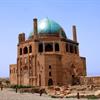Iran is situated in the Middle East and shares its borders with Pakistan, Iraq, Turkey, Turkmenistan, while its shores lie on the Caspian Sea and the Gulf of Oman. Tehran, the capital is a bustling, modern city that also offers well-preserved old buildings and monuments. Persian and other Persian dialects as well as Turkic and Kurdish dialects are spoken throughout the country.
The landscape in Iran is largely barren desert with mountainous regions in the west. Iraq has a history rich in culture, being one of the first countries to be occupied by the Islamic armies in the 7th century. The country boasts magnificent antique sights belonging to the Persian empire, notably in Tabriz with its restored blue mosque built in 1465 and the splendid square in Esfahan, once the capital of Persia, this is also a UNESCO World Heritage monument. Throughout the city there are mosques, palaces, bridges, bazaars and spectacular gardens reminiscent of the Persian Empire.
The salt lake town of Uromieh is also worth a visit as are Ardabil, Astara, Bandar-e Anzali and Rasht. Shiraz the capital of the Fars Province boasts beautiful ninth-century antiquities, while Persepolis is famous for its Ceremonial Seat of Darius, also listed as a UNESCO World Heritage site.
The climate is hot in the summer and harsh in the winter with very little rainfall. It is also a seismic zone.





















